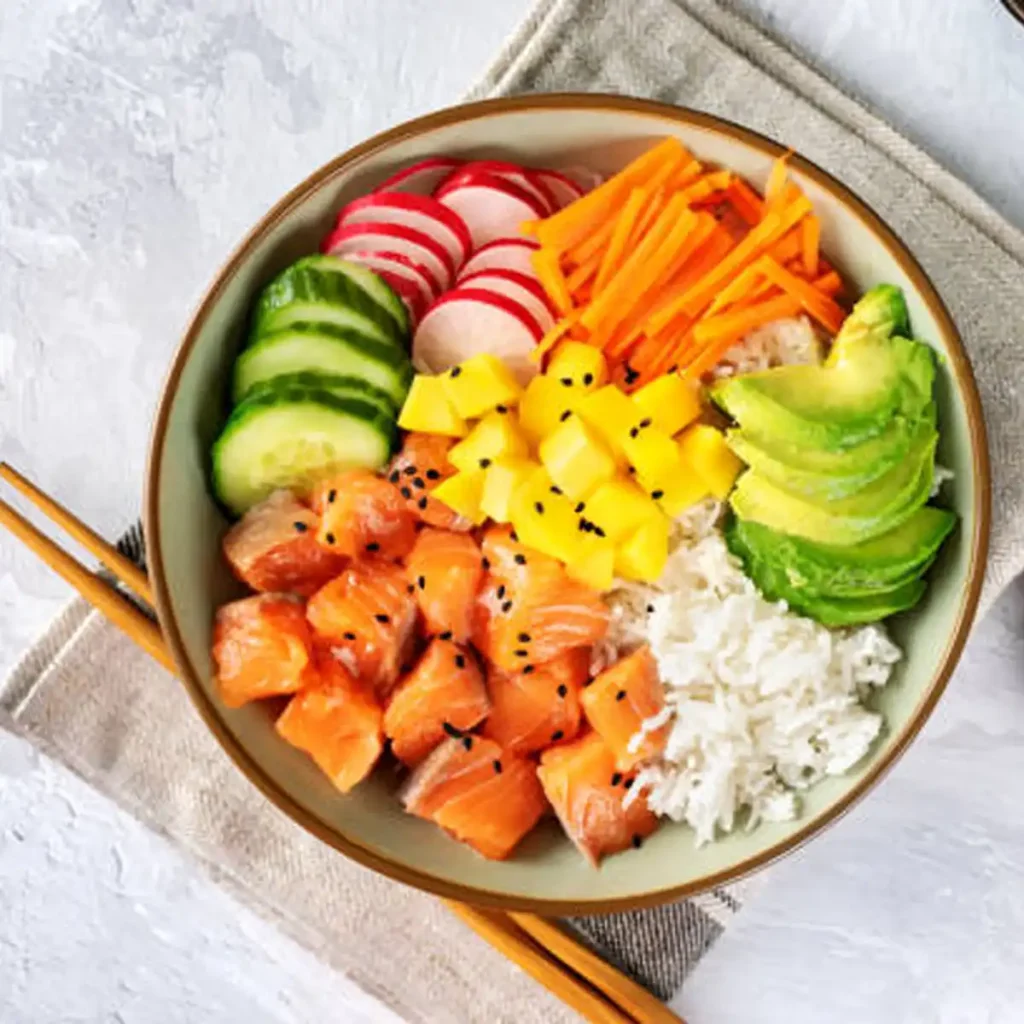A good poke bowl feels like a small victory on a hectic weeknight. Bright colours, clean flavours, fast prep. For health-conscious readers, it also answers a bigger need: a reliable route to high-protein meals with fibre, healthy fats, and vegetables in one bowl. The sticking point is safety. Many home cooks want the freshness of raw fish without guesswork. This feature sets out a practical, UK-specific approach that turns poke into a safe, affordable habit rather than a special-occasion project. You will learn how to source fish responsibly, how to assemble bowls using supermarket staples, and how to adapt recipes for every diet. The aim is simple. Make poke bowl recipes both credible and convenient so dinner on a Tuesday looks after your long-term health as well as your appetite.
Understand UK Safety Rules For Raw Fish
Labels such as “sushi grade” or “sashimi grade” are not regulated terms in the UK. They signal a vendor’s view on freshness, not a legal guarantee. The real risk with wild fish eaten raw is parasites. UK food hygiene legislation requires fish intended to be served raw to be frozen at −20°C for at least 24 hours, or at −35°C for at least 15 hours, to eliminate viable parasites. Home freezers are rarely ideal for this. They may not hold a stable −20°C, and they freeze too slowly, which spoils the texture.
There is one important exception that changes the home poke equation. Farmed, pellet-fed Atlantic salmon reared in biosecure conditions is exempt from the parasite-control freezing step because the life cycle of parasites is broken in that environment. For UK shoppers, this means you can buy fresh farmed Scottish Atlantic salmon from a reputable supermarket, keep the cold chain tight, and use it raw on the day of purchase. In this setting, your focus shifts from parasites to bacterial safety. That comes down to freshness, refrigeration, clean equipment, and good kitchen hygiene.
The same logic applies to high-welfare farmed rainbow trout from trusted UK producers. If you prefer to avoid raw fish entirely, cooked proteins and plant options keep poke firmly on the menu for everyone.
Simple buying checklist for UK supermarkets:
Choose Atlantic or Scottish salmon labelled as farmed. Prioritise freshness and an intact cold chain. Certification marks such as ASC or RSPCA Assured signal higher standards. Buy on the day you plan to eat. Transport the fish home cold. Refrigerate promptly in the coldest part of the fridge. Prepare with clean boards and knives, and eat immediately after assembly.
Important note for higher-risk groups: If you are pregnant or immunocompromised, follow NHS advice and avoid raw or lightly cured fish. Opt for fully cooked proteins like baked salmon flakes, cooked prawns, soy-ginger chicken, tofu, or tempeh. This keeps the spirit of poke while compromising on safety.
Shop Smart At Tesco Sainsburys Waitrose And Ocado
The major chains stock exactly what a home cook needs for safe, fast bowls. Look for fresh farmed salmon or UK farmed trout, vacuum-packed cooked prawns, and smoked fish for cooked options. For budget flexibility, tins of mackerel and sardines are ideal. Build out the rest of the basket with a microwave grain pouch, a bag of frozen edamame, a ripe avocado, a citrus or two, and a small set of sauces. This delivers a dependable bowl with minimal prep and strong nutrition.
To support sustainability, watch for ASC on farmed fish and MSC on wild fish. Some Northeast Atlantic mackerel fisheries have faced quota issues in recent seasons. When in doubt, reach for MSC-certified Cornish sardines or handline-caught mackerel from the South West. They bring similar savoury depth and improve the environmental picture.
Build A Balanced Bowl With UK Pantry Staples
Think in four layers: base, protein, veg, and finish. This simple model removes friction on weeknights and helps you hit nutrition targets.
Base options
Sushi rice gives that classic sticky bite. Rinse well, then use a tight lid and gentle heat so the grains keep their structure. For speed, a microwave pouch is the most effective hack. Tilda Sticky Rice is ready in about 90 to 120 seconds and makes healthy lunch ideas realistic. For fibre, use brown rice or quinoa. For quinoa that stays fluffy, cook with a 1 to 1.5 ratio of dry grains to liquid, rest for 10 minutes off the heat, then fluff with a fork. For a low-carb choice, blitz cauliflower into fine “rice” and either serve raw for crunch or sauté briefly until just tender. If pairing hot bases with raw fish, let them cool fully before assembly.
Protein choices
Raw: diced farmed Scottish salmon or UK farmed trout.
Cooked: roast salmon flakes, cooked king prawns, miso-glazed smoked mackerel, or tinned mackerel.
Plant: crispy tofu, glazed tempeh, or marinated chickpeas.
Finishes
Quick-pickle red onion, cucumber, or radish with rice vinegar, a pinch of sugar, and salt. Keep a rotation of crunchy toppings: toasted sesame seeds, nori strips, furikake, crispy onions, roasted chickpeas, or wasabi peas. Use seasonal produce for brightness and value: peas and radishes in spring, strawberries or gooseberries in summer as a tangy swap for mango, roasted squash and apples in autumn, kale and beetroot in winter.
Fun fact: UK Red Lion eggs follow strict safety protocols that drastically cut the risk of salmonella, which is why homemade mayonnaise made with these eggs is considered safe for most consumers.
Five Quick Sauces For Big Flavour
Sauce makes a bowl feel finished. Mix in a jar, shake, and keep chilled for the week.
Classic shoyu: Soy sauce, a few drops of sesame oil, grated ginger, and sliced spring onion. Use tamari for gluten-free.
Spicy gochujang glaze: Gochujang, soy sauce, rice vinegar, maple syrup, and sesame oil. Ideal for tofu or chicken.
Creamy miso-tahini: Tahini, white miso, lemon juice, maple syrup, and hot water to loosen. Plant based and dairy free.
Quick ponzu-style: Soy, fresh lime juice, a little orange juice, and rice vinegar. A simple route to that citrus-savory snap. If a recipe calls for yuzu, lime plus a touch of orange is a useful swap.
Sriracha mayo: Mayonnaise and sriracha to taste. To mimic Kewpie with UK mayo, add a splash of rice vinegar and a pinch of sugar.
A light miso-honey mix also works well as a glaze for baked fish. If you need mirin and do not have it, rice vinegar plus a half-teaspoon of sugar is a sound stand-in.
Ten Fast Recipes For Weeknights
All serve 2. Timings refer to active prep and cook time. Adjust heat and seasoning to taste.
1. Shoyu salmon in 15 minutes: Dice 240 g farmed Scottish salmon. Stir soy sauce with a little sesame oil, grated ginger, and sliced spring onion whites. Fold in the fish and rest while you prep. Heat a microwave sticky rice pouch. Spoon the rice into bowls, add the marinated salmon, sliced avocado, diced cucumber, thawed edamame, and spring onion greens. Finish with sriracha mayo and toasted sesame seeds.
2. ChalkStream-style trout with apple and radish: Cut 200 g UK farmed trout into cubes. Mix soy with mirin or a rice-vinegar-and-honey swap, add spring onions and a pinch of furikake. Marinate 10 to 15 minutes. Serve on cooled seasoned sushi rice with finely diced crisp apple, thin radish slices, grated carrot, and diced cucumber. Add a light ribbon of Kewpie or the UK mayo hack.
3. Teriyaki roast salmon flakes in 15 minutes: Bake two salmon fillets at 190°C, or 170°C fan, for about 10 minutes with a glaze of sweet chilli sauce, light soy, sesame oil, grated ginger, and a spoon of water. Microwave a sticky rice pouch and thaw edamame. Flake the cooked fish over the bowls with avocado and nori strips. Spoon over the pan glaze.
4. Lime and chilli marinated king prawn bowl: Whisk lime juice, chopped red chilli, and sesame oil. Season. Toss in 150 g cooked king prawns and rest 10 minutes. Serve over a pouch of mixed grains, warm or cold, with diced mango, avocado, radishes, and sliced spring onions. Use the leftover marinade as a dressing.
5. Miso-glazed smoked mackerel with veg stir-fry: Brush plain smoked mackerel with a quick mix of white miso and soy, wrap loosely in foil, and warm for 10 minutes at 160°C, or 140°C fan. Stir-fry sliced pak choi and sugar snaps in a little oil, then add a jasmine rice pouch and peas. Divide between bowls, add grated carrot, radish, and spring onion. Top with the hot fish and a dressing of rice vinegar, sesame oil, and lime.
6. Spicy tinned mackerel salad over rice: Flake two tins of mackerel in olive oil. Mix with Kewpie or the UK hack and sriracha to taste. Serve on cooled sushi rice with cucumber ribbons, thawed edamame, avocado, and thinly sliced red cabbage. Add pickled ginger and sesame seeds.
7. Soy-ginger chicken for weeknights: Coat bite-sized chicken thigh pieces with soy, honey, crushed garlic, grated ginger, and a little oil. Pan-fry until caramelised and cooked through, about 10 to 12 minutes, or air-fry at 200°C for 12 minutes. Serve on seasoned sushi rice with carrot matchsticks and cucumber. Dress with rice vinegar, sesame oil, and lime. Add crispy onions for crunch.
8. Sticky gochujang tofu in 20 minutes: Pat a block of extra-firm tofu dry and cut into cubes. Toss with cornflour and a pinch of salt. Fry in a non-stick pan with a little oil until golden on all sides. Pour over gochujang sauce, reduce the heat, and toss until sticky. Serve with brown rice, steamed broccoli, thawed edamame, and a spoon of kimchi if you like. Sprinkle with sesame seeds.
9. Smoky barbecue tempeh with red cabbage: Fry small pieces of tempeh in oil until crisp. Add a glaze of soy, chipotle paste, tomato purée, agave, and lime. Reduce to a sticky coating. Massage finely shredded red cabbage with lime and salt until it softens. Serve on seasoned sushi rice with edamame and a ribbon of sriracha mayo.
10. Chickpea and edamame with miso-tahini: Soak rice vermicelli in hot water for 3 to 5 minutes, then rinse cold. Toss chickpeas and thawed edamame with tamari, sriracha, sliced spring onions, and sesame seeds. Serve over the noodles with carrot and cucumber ribbons. Drizzle with miso tahini sauce for a gluten free poke that travels well.


Sustainability And Smarter Swaps In The UK
Good sourcing strengthens health goals. For farmed fish, look for ASC certification and producers that publish feed, welfare, and environmental data. For wild fish, MSC certification helps you support well-managed stocks. When mackerel is flagged as a concern, shift to MSC-certified Cornish sardines. For plant-forward bowls, lean into British produce and grains to keep transport miles low. Quinoa and brown rice remain excellent bases; for even more fibre, add roasted chickpeas or edamame to boost protein and texture.
Meal Prep Without Risk
Raw fish is a buy-and-eat-today ingredient. Do not portion raw fish for several days of lunches. You can still prep wisely. Batch-cook your grains on Sunday and cool them quickly. Shred hardy vegetables such as red cabbage and carrots, and thaw edamame. Shake up two sauces from the section above. Cook your chosen protein if you are using chicken, tofu, or tempeh. Store each element in its own container. In the morning, assemble the base and vegetables, add cooked protein or pack a space for same-day salmon or trout, and carry the sauce separately.
For readers who follow omega 3 benefits content, cooked salmon flakes offer a steady, lunch-friendly supply with no safety trade-off. Internal resources such as our guide to omega 3, our weekday meal prep guide, why fibre supports gut health, easy dairy free swaps, and a primer on gluten-free choices in London are useful companion reads.
Lunchbox Layering That Stays Fresh
Moisture control matters. Use a main container and a small pot for liquids.
Layer 1: Base grains or quinoa.
Layer 2: Hardy vegetables and protein.
Layer 3: Soft items such as avocado or cucumber plus crunchy toppings.
Small pot: All dressings and glazes.
A light slick of oil on grains prevents clumping. Add the sauce at the last minute. If you plan to add raw fish at lunch, keep it fully chilled until you serve, then assemble and eat immediately.
Frequently Asked Questions For UK Shoppers
Is supermarket salmon safe to eat raw
Yes, if it is farmed Atlantic or Scottish salmon from a trusted UK retailer and used on the day of purchase. Keep it cold from store to table and follow strict hygiene. This exemption does not apply to wild fish.
What does sushi grade mean in the UK
It is a marketing phrase, not a regulated safety standard. Wild fish intended for raw service must be commercially frozen to the required temperatures. The farmed salmon exemption allows a faster route for home cooks.
Can I use tins
Yes. Tinned salmon, mackerel, or sardines make quick and affordable bowls. Drain, season, and pair with grains and crunchy vegetables.
Can I eat poke while pregnant
Choose cooked proteins only. NHS guidance asks pregnant women to avoid raw and cold-smoked fish due to Listeria risk. Bowls with cooked chicken, cooked prawns, cooked salmon flakes, tofu, or tempeh are suitable.
What is the quickest base
A microwave pouch. Tilda Sticky Rice is built for sushi-style dishes and heats in roughly 90 seconds. Brown rice or mixed grain pouches are strong, fibre-rich options.
Can I use wild tuna
Only if it has been commercially frozen to the correct standards. Do not buy a fresh thawed steak from a counter and eat it raw at home. For speed and safety, raw farmed salmon or trout is the reliable choice.
Is there a good UK-farmed alternative to salmon
Yes. Farmed rainbow trout from reputable producers offers great texture for raw use and a lower transport footprint.
What is a quick mirin swap
Use rice vinegar with a touch of sugar or honey.
How do I mimic Kewpie mayo with UK ingredients
Whisk UK mayonnaise with rice vinegar and a little sugar to add tang and umami.
Conclusion Make Poke Work For Real Life
Safe poke at home is not a gamble. It is a system. Buy farmed salmon or UK farmed trout the day you plan to eat. Keep it cold. Use clean tools. Build bowls from a small, reliable set of ingredients so you can change flavour without adding stress. Keep a jar of sauce in the fridge and a grain pouch in the cupboard. For those who must avoid raw fish, cooked and plant proteins keep the format intact and the nutrition strong. In practice, a bowl built this way delivers steady energy, anchors a week of healthy eating, and supports long-term goals with minimal effort.





